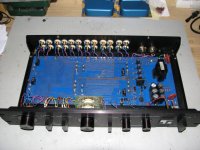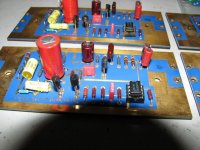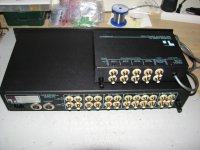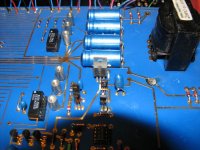To allow for an easier search, I decided to open yet another thread about the Threshold NS10.
Hoping this might be useful for others, here are the considerations behind the work done.
Some time ago, I was lucky to find a Threshold NS10 for sale with the rare M1 moving coil box in near mint condition. Bought it, and set out to renew it.
I didn’t want to make too big changes, wanting to keep the preamp pretty close to the original.
The sound was a bit dull (dark) to start with. Lacking details in the topend it didn’t produce much soundstage. (Comparing it to the X-CCS-CC-BosoZ,) Something had to be done about it.
Here is how it looked before:
http://www.diyaudio.com/forums/showthread.php?postid=979962#post979962
This is how it looks now (without the shielded modules)
Steen
More to follow.
Hoping this might be useful for others, here are the considerations behind the work done.
Some time ago, I was lucky to find a Threshold NS10 for sale with the rare M1 moving coil box in near mint condition. Bought it, and set out to renew it.
I didn’t want to make too big changes, wanting to keep the preamp pretty close to the original.
The sound was a bit dull (dark) to start with. Lacking details in the topend it didn’t produce much soundstage. (Comparing it to the X-CCS-CC-BosoZ,) Something had to be done about it.
Here is how it looked before:
http://www.diyaudio.com/forums/showthread.php?postid=979962#post979962
This is how it looks now (without the shielded modules)
Steen
More to follow.
Attachments
Changing the caps was the first thing that came to mind of course, and this remark from
Mr Pass cleared any doubts one could have about the Tantal caps used in the original:

All capacitors from 220uF and down are Tantals in the original.
I used the exact same values as the original except for the PSU cap’s before the regulator.
Regarding the input and output caps: Film caps are out of the question. Especially the output caps
of 47uF would never fit in the cans, nor on the boards. Only candidate really is an electrolytic.
I chose Black Gate Non polar for those. I bought those from Peter Daniel, since there is no supplier around here.
The local decoupling caps I used are Elna Starget. I figured that a dedicated audio capacitor would be the best choice in the line and RIAA modules. RS-components stock those.
Capacitors for the power supply were changed to Panasonic FC types. The original PSU had 11oouF in it. Not much by DIY standards, so I upped that to 6000uF. Btw the supply regulation consists of one FT317 for both channels, followed by what seems to be a R-C filter made up of 4 resistors and 4 330uF electrolytic’s, feeding one module each.
The capacitors in the RIAA eq. circuit are Polystyrene/foil types, so no need to replace them. Thanks to Malotron for the info on that.
This pic shows one of the modules with new cap's installed. I let the 7pF sit since its a dipped Mica.
Still more to follow.
Mr Pass cleared any doubts one could have about the Tantal caps used in the original:
Last time I encountered a forest of tantalums with some unknown shorts, I hooked the board up to a high current supply and burned them out of the circuit.
All capacitors from 220uF and down are Tantals in the original.
I used the exact same values as the original except for the PSU cap’s before the regulator.
Regarding the input and output caps: Film caps are out of the question. Especially the output caps
of 47uF would never fit in the cans, nor on the boards. Only candidate really is an electrolytic.
I chose Black Gate Non polar for those. I bought those from Peter Daniel, since there is no supplier around here.
The local decoupling caps I used are Elna Starget. I figured that a dedicated audio capacitor would be the best choice in the line and RIAA modules. RS-components stock those.
Capacitors for the power supply were changed to Panasonic FC types. The original PSU had 11oouF in it. Not much by DIY standards, so I upped that to 6000uF. Btw the supply regulation consists of one FT317 for both channels, followed by what seems to be a R-C filter made up of 4 resistors and 4 330uF electrolytic’s, feeding one module each.
The capacitors in the RIAA eq. circuit are Polystyrene/foil types, so no need to replace them. Thanks to Malotron for the info on that.
This pic shows one of the modules with new cap's installed. I let the 7pF sit since its a dipped Mica.
Still more to follow.
Attachments
All the RCA sockets were changed to gold plated/Teflon insulated types. 17 pairs are needed to replace them all, including the M1 moving coil box. I didn’t want to change some of them only, since the preamp would turn out ugly. I am never going to use the Tape connections, though.
The signal wiring was all changed to OFC/silver plated/Teflon insulated signal wire.
All the internal signal wires had a ground wire twisted around it, I stayed with that procedure.
The volume pot of the original was changed to an Elma gold plated attenuator. The attenuator uses good old Phillips metal film 0,6Watt resistors.
The previous owner had already installed new balance pots, and I decided to let them sit for now.
Everything else was cleaned and polished, especially the standoffs holding the modules. They actually acts as connectors to the main pcb! The ends of the standoffs were somewhat tarnished, where they meet the module pcb’s. I thought it well worth doing that, of course.
It was very tempting to disconnect the tape selector and tape loops together with the balance pots, since this would shorten the signal path considerably, but I resisted since it would also change the original design too much for my taste.
Here is a pic from the rear with the new and shiny sockets:
Still more to come.
The signal wiring was all changed to OFC/silver plated/Teflon insulated signal wire.
All the internal signal wires had a ground wire twisted around it, I stayed with that procedure.
The volume pot of the original was changed to an Elma gold plated attenuator. The attenuator uses good old Phillips metal film 0,6Watt resistors.
The previous owner had already installed new balance pots, and I decided to let them sit for now.
Everything else was cleaned and polished, especially the standoffs holding the modules. They actually acts as connectors to the main pcb! The ends of the standoffs were somewhat tarnished, where they meet the module pcb’s. I thought it well worth doing that, of course.
It was very tempting to disconnect the tape selector and tape loops together with the balance pots, since this would shorten the signal path considerably, but I resisted since it would also change the original design too much for my taste.
Here is a pic from the rear with the new and shiny sockets:
Still more to come.
Attachments
So how does it sound now? In one word: Superb. I was very surprised to find that the difference was so big. The sound is now crystal-clear and detailed. The soundstage is tremendous. I guess all the little things done, added up to a really good result. Both the Line and the RIAA sounds good. The RIAA was not much to write home about initially, but now it sounds fine. I like to think that this is how Mr. Pass meant it to be sounding from the start. I want to add though, that I think the NS10 might be a little unforgiving. If you have some weaknesses in your playback chain, I don’t think the NS10 will do much to cover it up! (Like a BosoZ tends to do) If your phono-cartridge is a bit “ringy” in the topend, the NS10 will let you know without mercy. Right now the NS10 is connected to the Babbelfish (Aleph-J clone) and the combination is just great. The NS10 drives the Babbelfish with real authority (better than the x-bosoZ used singleended-out) I like this preamp more and more.
20+ working hours and 300USD later you might want to ask: Was it worth it?
The answer is: Absolutely.
Steen
20+ working hours and 300USD later you might want to ask: Was it worth it?
The answer is: Absolutely.
Steen
Its actually on the big mainboard. It sits to the right in the first picture.Could you attach an image of this board?
Here is a closeup of the FT317 with the 330uF's sitting behind it.
Steen
Attachments
Thanks,
It is made by Solid State Inc.
the first line is FT317, I can't read the second, maybe 7812TO.
the code seems voltage regulator... but are you sure?
Those parts are also inside old threshold Amps (FT317 & FT417) but there's a bit of confusion about them: just searching the forum.
I have FT317 7807TO, FT417 7907TO and FT317 7807 in the same amp. An old post consider a good substitution of them with MJ 15030/31... these are NPN and PNP drivers and surely not regulators.
Piero
It is made by Solid State Inc.
the first line is FT317, I can't read the second, maybe 7812TO.
the code seems voltage regulator... but are you sure?
Those parts are also inside old threshold Amps (FT317 & FT417) but there's a bit of confusion about them: just searching the forum.
I have FT317 7807TO, FT417 7907TO and FT317 7807 in the same amp. An old post consider a good substitution of them with MJ 15030/31... these are NPN and PNP drivers and surely not regulators.
Piero
I am pretty sure the FT317 is an adjustable voltage regulatorthe code seems voltage regulator... but are you sure?
Steen
steenoe said:............................... I want to add though, that I think the NS10 might be a little unforgiving. ..............
ya remember that I told ya,in one of NS10 related threads,during mono tests ...developing Chokyfied shunt reg.........that NS10 is simply brutal.......
hehe
welcome in world of something greater feedback .........than you are used with recent NP's gadgets
(we wouldn't tell that this feedback is still adequate,don't we....? )

I'm glad for ya
now imagine same preamp ,without caps in chain and with every stage dedicated nice shunt reg..........
I wouldn't say that this will sound better,or mucho different .......but certainly will be fun to make it.
keep that Jewel busy
Zen Mod, thanks for the reply
 )
)

I am sure the NS10 stays in the main system for now, together with the Babbelfish, which sounds even more dynamic with the NS10 to drive it.
Steen
Yep, and I actually thought about what you said way back.... You think its because of more feedback? Its brutal and way more powerful than my X-BosoZ (which sounds a bit whimpy in comparisonthat NS10 is simply brutal
Yeah, that would be great indeed. I never liked caps in the signal path, but the BG nonpolars does actually a good job. I was always a sceptic about those, but.... somehow they manage to sound pretty goodnow imagine same preamp ,without caps in chain and with every stage dedicated nice shunt reg..........
I am sure the NS10 stays in the main system for now, together with the Babbelfish, which sounds even more dynamic with the NS10 to drive it.
Steen
Pardon mine tooPardon my ignorance but what's with the servo and o/p cap?
Steen
Hey Analog_sa I think mine is just like yours This schematic is just what my NS10 looks like. What I doped the outputcap is the 47uF in series with the output of course. I have the lm307 also. Why the outputcap is still needed, I hope you can tell me
This schematic is just what my NS10 looks like. What I doped the outputcap is the 47uF in series with the output of course. I have the lm307 also. Why the outputcap is still needed, I hope you can tell me
Steen http://www.diyaudio.com/forums/showthread.php?postid=884496#post884496
http://www.diyaudio.com/forums/showthread.php?postid=884496#post884496
Steen
cviller said:Doesn't it just place the transistors nicely between V+ and gnd?
Edit: I'm referring to the servo circuit. And I see no negative supply so + on lm307 would be 1/2 V+ - to my understanding.
Of course you're right. Never noticed there's no negative supply. Cap's gotta stay.
That will make me sleep tightCap's gotta stay.
Well now that I am posting anyways, I am thinking if its possible to squeeze a little more performance out of this circuit? The best bet is for sure Apassgears, with a shunt reg supply. Have a look here: http://www.diyaudio.com/forums/showthread.php?s=&threadid=76557
You let me know
Steen
- Status
- This old topic is closed. If you want to reopen this topic, contact a moderator using the "Report Post" button.
- Home
- Amplifiers
- Pass Labs
- Threshold NS10 renewed




